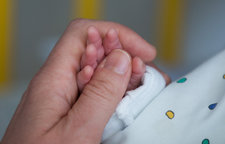 Editor’s Note:
Editor’s Note:
Obviously, this article on at-home care is not directly relate to community-based midwifery for healthy women with normal pregnancies choosing OOH childbirth services. However, it does address the increasingly dramatic changes in the social and medical role of acute-care hospitalization.
Since the 1950s, the assumption in the US had been that anyone who was really ill, injured, elderly or in labor would naturally be better off in a hospital. That’s when doctors stopped making house calls and instead hospitalized all patients that might any need daily attention or evaluation. Instead of spending several hours driving to the family homes of each patient in the category, doctors greatly appreciated the time-saving convenience of simply driving to their local hospitals and do their “rounds” each morning or evening as they chose.
After 70 years of increasing numbers and increasing cost of hospitalization, the scientific evidence now confirms what many of us have already concluded from personal experience or commonsense — the type of care routinely provided in hospitals is NOT, as we assumed for more than half a century, the best answer for many different types of health & medical situations.
That conclusion is based both on the scientific outcome described in the following article and also factoring in the unproductive cost of hospitalization, in which hospital patient are exposed to iatrogenic and nosocomial complications that are additionally expensive and far too often, result in a preventable death or permanent disability from medical mistakes and deadly hospital-acquired infection.
As every single medical discipline is working to provide care the is less invasive and reduced the need, or at the length of hospitalization, the obstetrical profession continues to push for 100% hospitalization of all laboring women, increasing the amount of routine interventions in pregnancy and childbirth, increasing reasons for doing elective (non-medical) inductions and Cesarean deliveries.
As a 21st century medical-surgical discipline, obstetrics is still based on an incorrect set of 19th-century assumptions that defined childbirth itself, whether or not the mother did or did not have any complication, to be the equivalent of a 9-month disease requiring a surgical cure.
If the obstetrical profession were to acknowledge that well over 8o% of the women who become pregnant are themselves healthy, have normal pregnancies that will be carried to term and don’t need or benefit from the discipline of obstetrics. Under those circumstances, obstetricians would logically refer healthy women to the care of midwives; instead of attending normal births, they would their professional services on the care of women who have reproductive issues such as infertility, cysts, tumors and pathologies, complications of pregnancy and/or requires operative delivery (forceps/vacuum extraction or Cesarean delivery.
Hospital-at-Home Care Improved Outcomes, Patient Satisfaction
Patients receiving a new model of hospital-at-home (HaH) care had better outcomes, greater satisfaction, and no increased rate of adverse events compared with similar patients who received traditional inpatient care, a study has found.
Length of inpatient care stay, readmission rates, and emergency department revisits were nearly half as high in the HaH group compared with traditional inpatient care, the researchers write.
Alex D. Federman, MD, MPH, from the Icahn School of Medicine at Mount Sinai in New York City, and colleagues published their findings online June 25 in JAMA Internal Medicine. The study was limited, however, by its observational nature and its potential for selection bias.
The new model combined HaH care (acute hospital-level care in the patient’s home instead of the hospital) with 30 days of transitional care after the acute event. The researchers estimate a cost savings of 19% to 38%.
They compared outcomes among 507 adult Medicare patients who had an acute medical illness requiring inpatient care between November 2014 and August 2017. The patients came from one of two New York City emergency departments or from home or physician referrals in the area.
The patients’ average age was 74.6 years, and 68.6% were women. The only notable differences between the two groups was that those in the HaH group tended to be older and more often had a functional impairment before the acute event.
All the patients qualified for HaH care, and 295 chose it; the remaining 212 turned it down or required care in the emergency department when HaH intake was not available.
In addition, the study excluded patients who were “clinically unstable, needed required cardiac monitoring or intensive care, lived in an unsafe home environment, or resided outside of Manhattan,” the authors explain.
HaH care involved a physician or nurse practitioner providing acute care services at the patient’s home, including exam, vital signs, illness monitoring, intravenous fluids, wound care, and patient education. A nurse visited the patient at least once a day, and a physician or nurse practitioner visited in person or by video call at least once a day. Necessary equipment was brought to the home, and a social worker made at least one house call per patient.
Significantly Shorter Length of Stay
During 30 days of follow-up after the acute episode, HaH patients had an average 3.2 days of acute inpatient care compared with 5.5 days among those who received traditional inpatient care. The 2.3-day difference in length of stay was statistically significant (95% confidence interval [CI], 1.8-2.7 days; weighted P < .001).
